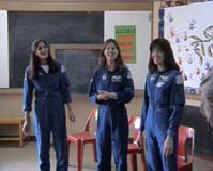|
HERE ON EARTH....A TRYST WITH NASA
Vasant Valley school had the unique opportunity to interact with astronauts from NASA on the contribution of Kalpana Chawla followed by a Q&A session on various aspects related to research and work done at NASA.
SUNITA WILLIAMS, TRACY CALDWELL and JANET KAVANDI were the three astronauts who visited us along with JEAN-PIERRE HARRISON, Kalpana Chawla’s husband. Janet Kavandi, who has been to space 3 times now , started out in the same year as Kalpana and got to interact with her on a professional and personal level. Tracy Caldwell and Sunita Williams emphasized that Kalpana was an extremely determined ,hardworking and passionate about her work
All the astronauts spoke about their training and experience at NASA. They talked about the various aspects of training, the theoretical brain racking bit, and the fun lessons in the flight simulators. Piloting is just one aspect of the shuttle, the other being the work done by the mission specialists who perform various physical and biological experiments.
After the talk on center stage , class 10 and 12 got the privilege of watching an exclusive video on Kalpana Chawla. This was followed by a Q&A session with various questions asked by the students. Some of the questions were as followed:
1.Why was Columbia chosen for this mission even though it was the oldest space craft?
Ans . Colombia was the oldest space shuttle yet it was the only space craft that could have gone on this mission as it was the heaviest orbiter and could not be used in any other flights as it could not carry any other components that had too much mass. Most of the other missions focused on carrying these components to the international space station which also needed docking facilities that were not present in Columbia .
2.What kind of experiments were being carried out on this mission?
Ans. There were various experiments relating to earth sciences: physical and biological being carried out. The ones related to biosciences included observing the response of their bodies (used as test-beds) to the effects of microgravity. One of the other experiments involved studying the circular form taken by candle flames in space due to the effect of microgravity.
3.What are the various qualifications required?
Ans. There are 2 kinds of astronauts -the ones who pilot the space shutlle, mainly landing and orbiting, the second kind are the mission specialists who perform the experiments. A degree like the masters /bachelors/phd in science or engineering is required. Lots of the astronauts also belong to the services like the army, airforce and the navy.
4. Does it take time to adjust to the feeling of being in space?
Ans. Yes it takes around 5 minutes but after that you are completely comfortable. It turns out to be a lot of fun.
5. Do all NASA astronauts get to go to space?
Ans. The idea is for everyone to go to space. However the opportunities are limited because there are only 3 shuttles and not more then 7 people on a 15day mission.
6.What is NASA planning for the future?
Ans.The future holds plans like completing the international space station, which should have a service life of around 15yrs. Experiments on earth sciences physical and biological will carry on . Exploring farther to planets like Mars is also being considered as part of the curriculum.

By Rubaina Khan
XII - B
|